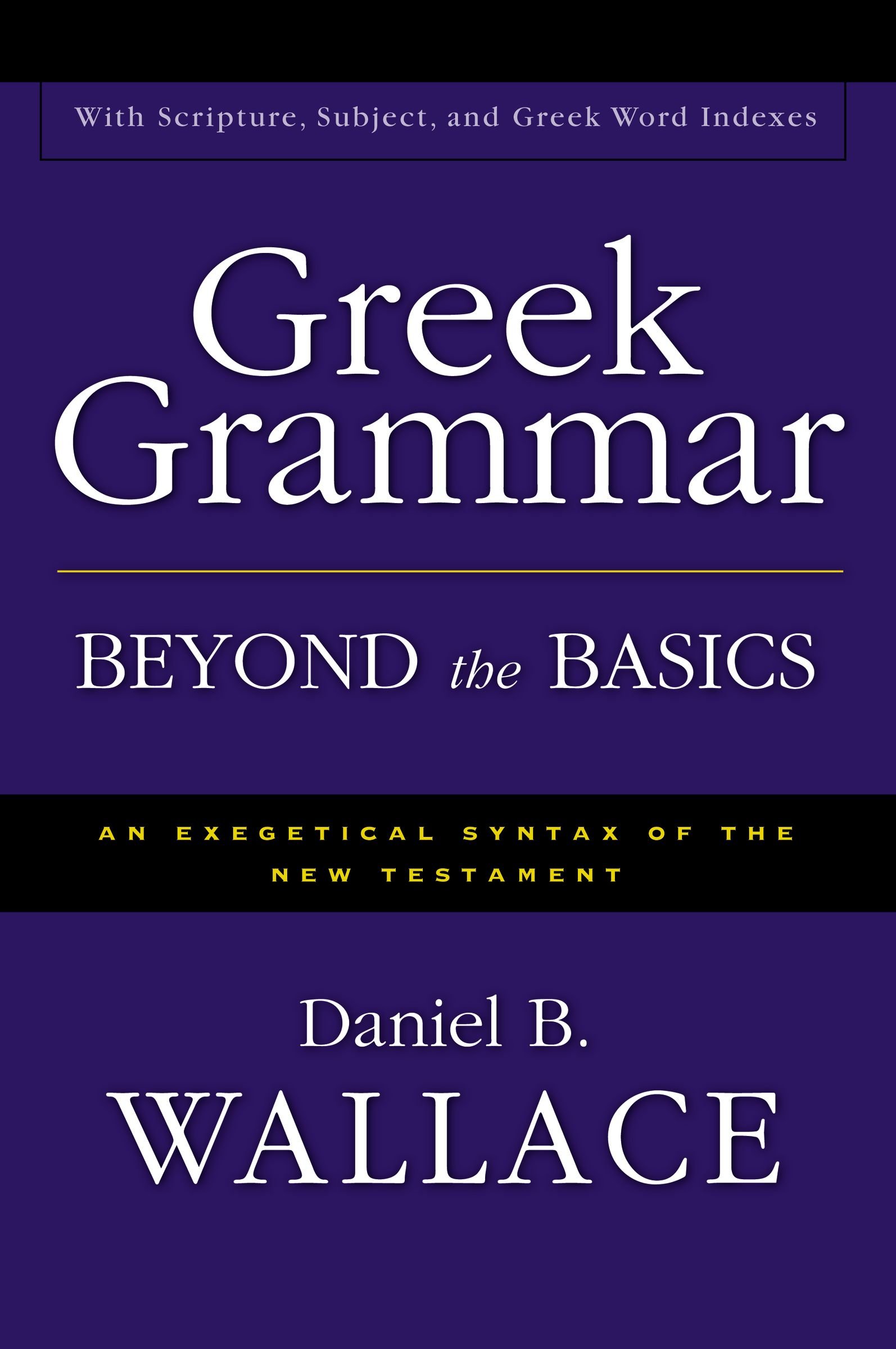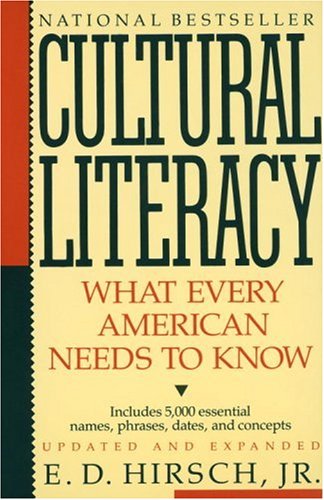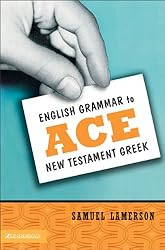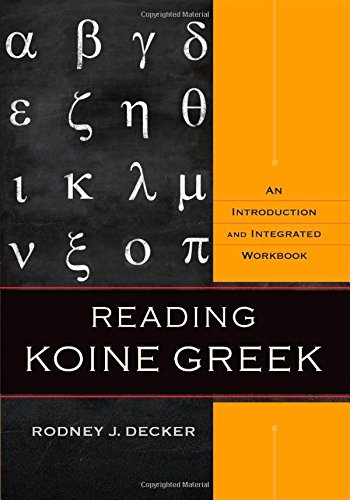Rodney Decker has produced a large (704pp), new Koine Greek grammar that focuses on translation from the very beginning and includes extra-biblical Greek to allow exposure to wider selection of example sentences. This work is entirely suitable for use in Greek 1 & 2; the professor may find the following review helpful for determining whether it fits his or her tastes before ordering a review copy.
Approach of the Book
Decker begins with a lengthy and informative discussion of the Greek language. There are helpful maps, tables, and several pictures of Greek manuscripts or tablets. After the chapter on the alphabet, which is heavily and helpfully illustrated, he begins with all four cases of nouns. He gives 2-1-2 case endings and the article paradigm in these early chapters to memorize, which may daunt the student, but the rote memory lightens up pretty quickly and the focus moves to translation. Rather than assigning 50+ paradigms, he has a core of necessary paradigms, and for verbs and participles he prefers morphological formulas.
After some pronouns, he briefly hits the basics of verbs and introduces the present active indicative and the aorist active indicative. He moves from there to conjunctions, prepositions, and other pronouns, third declension nouns, and then comes back in ch. 13 to verbs. At this point he discusses in depth the Greek verb system, and then has a chapter on the various tenses and voices. He covers the present active indicative and the aorist active indicative again, making the material a bit redundant, but at this point the student has a better understanding of the semantics of each tense-form. It may be a bit helpful to introduce the two paradigms early and revisit them later, but it is a contributing factor to the book’s size. After he covers the indicative, he moves to infinitives and participles, then the other three moods, then to conditionals and direct/indirect discourse, and concludes with two chapters on -μι verbs.
His introduction of the four noun cases is natural since language acquisition usually begins with nouns. It is also helpful that he finishes the entire indicative before moving on to other moods. The downside to this, however, is that there are 21 chapters to finish the indicative, and only 8 chapters for all of the other four moods (including participles). Having only two chapters on -μι verbs (and including them at the very end) has the same effect. The student may not get a solid grasp on the material in such a short span of chapters, and the -μι verbs always seem to come right at the end of Greek 2 when the students are completely burned out.
Layout of the Chapters
Each chapter begins by introducing the concept and explaining any grammar that may need to be known (on which, see below). After giving any paradigms needed and explaining them, he gives several examples using mostly the NT, but also the LXX, Pseudepigrapha, and Apostolic Fathers. Next comes a double-columned “Now You Try It” section, which gives in the left column a Greek sentence with relevant words for the chapter in bold, and in the right column several questions about the sentence. These make excellent exercises for the classroom. This section follows each explanation of new concepts, so there may be multiple “Now You Try It” sections per chapter.
Following these sentences is a lengthy passage, usually around 7-12 verses, with words in bold that should be recognized from that chapter’s lesson. Many words are glossed in parentheses, while others have footnotes to help the student work their way through the paragraph. Afterward come the vocabulary. And here Decker has done a wonderful job by providing not only “possible glosses,” as most books do, but also the frequency of each word and a full definition in English (e.g., αιον is “a long period of time, in either the past or the future; a segment of time as a particular unit of history; eternity [if context suggests no end]” [200]). This approach to vocabulary helps the student overcome the idea of translating vocab words as 1:1 correspondences and helps them to think about words in terms of their actual definitions, not in terms of their English glosses. He also provides extended discussions of the morphology of certain words, e.g., δοξα’s third declensional endings (60).
Each chapter concludes with a bullet-point-type summary of the “Key Things to Know” for that chapter.
Encroachments on Intermediate Grammars
Decker includes more intermediate grammar material than most other grammars (e.g., Machen, Mounce, and Croy, with which I am most familiar). For example, he provides extensive information on the function of infinities with sentence diagrams and plenty of examples (364-380). He explains the eight types of adverbial participles, as well as attendant circumstance participles (416-419). He also discusses at length the four types of conditional clauses with examples (500-508).
 I am torn on these discussions of intermediate material. On the one hand, they are simple enough to introduce to the student early; yet they are not quite extensive enough in explanation to supplant an intermediate grammar, such as Wallace’s popular Greek Grammar Beyond the Basics. The effect is, positively, to help the student understand the complexities of various parts of speech early in Greek 1 & 2, but, negatively, to make the chapters longer and to cause some redundancy in Greek 3/4. The professor could choose to skip over these portions, but that would require a lot of planning beforehand to delineate the exact page numbers for which the students are responsible.
I am torn on these discussions of intermediate material. On the one hand, they are simple enough to introduce to the student early; yet they are not quite extensive enough in explanation to supplant an intermediate grammar, such as Wallace’s popular Greek Grammar Beyond the Basics. The effect is, positively, to help the student understand the complexities of various parts of speech early in Greek 1 & 2, but, negatively, to make the chapters longer and to cause some redundancy in Greek 3/4. The professor could choose to skip over these portions, but that would require a lot of planning beforehand to delineate the exact page numbers for which the students are responsible.
Some of the length of the book is cut down if one does not assign or use the “Advanced Information for Reference” sections. However, they are not all exactly advanced. He puts comparative and superlative adjectives in this section (110), but these should surely be required for Greek 1 & 2 students.
Extensive, but Necessary Discussions
 There are several extensive discussions that contribute to the size of this book that perhaps would not have been required decades ago. With the turn away from the importance of humanities and languages in American education during the twentieth century (on which, see Hirsch’s Cultural Literacy), many college and seminary students have no foundation for learning Greek grammar until they have been taught the corresponding English grammar.
There are several extensive discussions that contribute to the size of this book that perhaps would not have been required decades ago. With the turn away from the importance of humanities and languages in American education during the twentieth century (on which, see Hirsch’s Cultural Literacy), many college and seminary students have no foundation for learning Greek grammar until they have been taught the corresponding English grammar.
 That is the premise behind the recently published English Grammar to Ace Biblical Greek, which is a helpful book. But Decker’s volume supplants the need for an extra volume on English grammar by teaching the student these concepts at length in each chapter. For example, he explains the concept of morphemes, of participles, of conditionals, of tense and aspect in the English verbal system, and so forth. It is more helpful to have the grammar discussions in the textbook than to expect the student to continually refer to a separate book explaining these concepts.
That is the premise behind the recently published English Grammar to Ace Biblical Greek, which is a helpful book. But Decker’s volume supplants the need for an extra volume on English grammar by teaching the student these concepts at length in each chapter. For example, he explains the concept of morphemes, of participles, of conditionals, of tense and aspect in the English verbal system, and so forth. It is more helpful to have the grammar discussions in the textbook than to expect the student to continually refer to a separate book explaining these concepts.
Prepositions are explained somewhat fully, nearly to the extent that they are treated in intermediate grammars. This is actually a welcome expansion for a beginning grammar, since it will help students to learn early how they function and advance discourse.
Lastly, Decker does the professor a huge favor by including discussions and figures to teach the student how to use a lexicon. On p. 51-52 he gives the entry for θρονος from three lexicons: Danker’s Concise Lexicon, BDAG, and Louw-Nida. He explains briefly how to read these entries. On p. 279, he gives the BDAG entry for αρχω and explains how to read many of its details (although he does not explain how to read the extra-biblical references). These illustrations and explanations help the student learn to read a lexicon from the beginning and give them a reference to continually refer back to.
Verbal Aspect and Aktionsart
The last note of interest is how Decker handles explaining time, aspect, and Aktionsart in the Greek verbal system. He does take on the task of explaining it in a decent amount of detail, although the student will still need supplemental lecture from the professor and readings from intermediate grammars. He uses the three aspects of perfective (aorist), imperfective (present, imperfect), and stative (perfect, pluperfect) and explains the concept well. He takes the aorist as the default tense, which to him means there is nothing significant about its use (118), while the use of any other aspect is significant. The imperfective tense-form differs from the present tense-form by signifying remoteness and is used to background information, while the present and aorist tense-forms foreground information (263). If the professor agrees with Decker on all or most of his take on aspect, the textbook will be easily used in the classroom. However, Decker does not note any differing theories on, say, the perfect tense (e.g., C. Campbell’s views), so any views differing greatly may get confusing in the classroom after the students have read the textbook. He leaves discussions of Aktionsart completely for intermediate grammars.
Appendices
There are five content appendixes plus a glossary, which gives full definitions rather than simply glosses. The standard charts are included in appendices A and C. The vocative is covered in appendix D. Appendix B is quite helpful, giving all the rare or difficult forms for the most common verbs in the NT and LXX, as well as providing odd forms with various morphological changes the beginning student will need to learn.
Summary
Decker’s grammar is a welcome addition to the available textbooks on the market. This grammar has much to offer. Its bulk may intimidate the beginning student, but its bulk is also its great strength. It educates students on many areas that other grammars do not, and it essentially includes its own workbook with its many examples and sample reading paragraphs. His emphasis on translation from the first chapter on nouns is a welcome move to help immerse students in the language as much as possible. The pictures, tables, and illustrations are all great aids to the student. I would highly recommend this textbook for use in the classroom, provided it meets the professor’s expectations.
Edit: I just learned that Dr. Decker died of cancer last year. His wife has made beautiful testimonial posts on his blog which you can find here: http://ntresources.com/blog. Dr. Decker also made several posts in the last stages of his cancer that are touching and encouraging. According to his wife, Dr. Decker would have been very well pleased to see how his book turned out.


2 comments